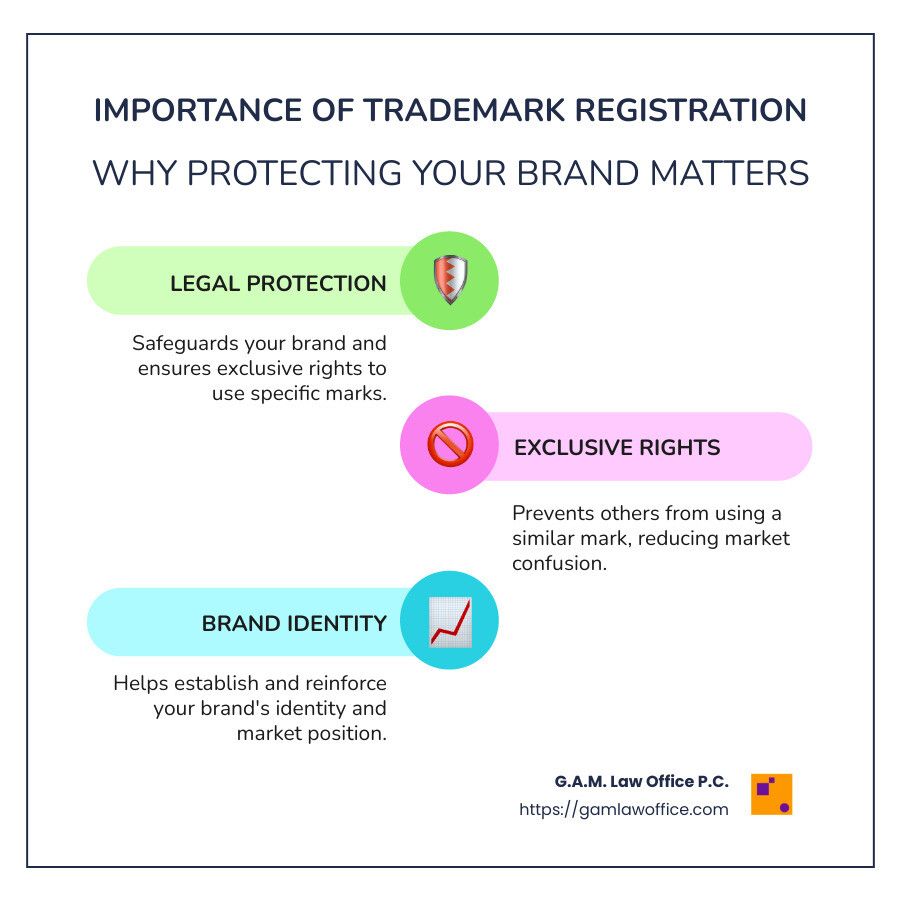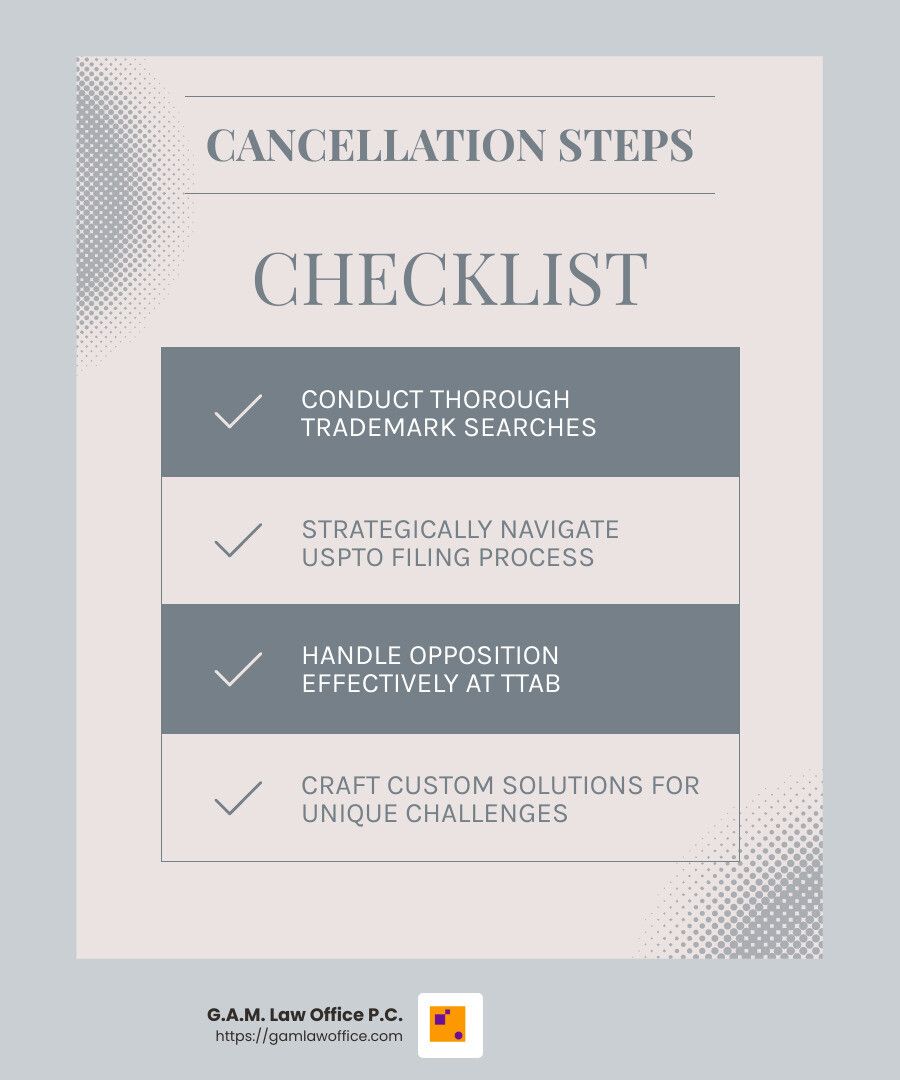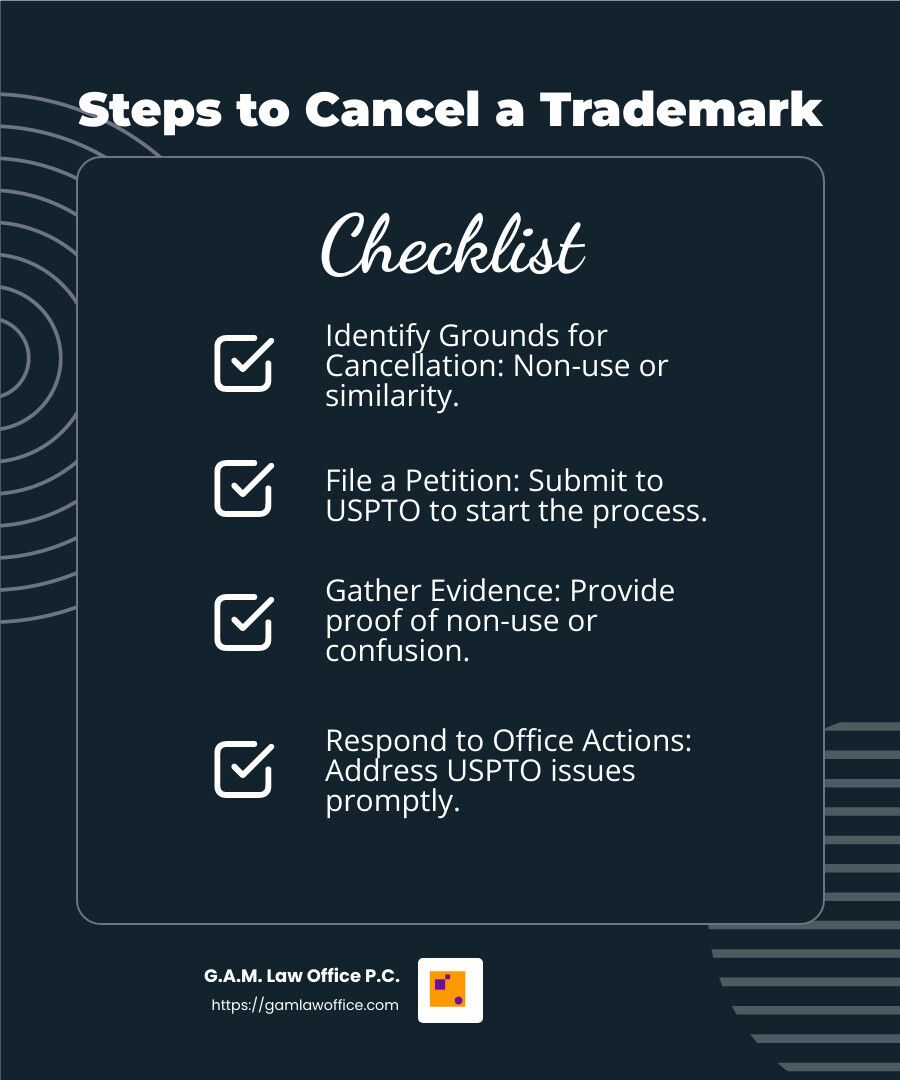- within Intellectual Property topic(s)
- with readers working within the Law Firm industries
Trademark Cancellation
Trademark cancellation is important for everyone managing intellectual property. Trademarks protect your brand identity, not just your logo or name. They also help safeguard business assets. Protecting a trademark gives you the exclusive right to use it. This stops others from using similar names or logos that might confuse customers. This is vital for new and long-established businesses alike.
Understanding the basics of trademark registration and the importance it holds is vital. A registered and well-managed trademark provides legal protection that secures your brand's reputation and competitive edge. Without it, you risk imitation and potential market confusion.
As a trademark attorney, I always emphasize the significance of addressing trademark issues proactively, this is one of the ways I assist clients in navigating trademark complex processes to ensure their brands are well-protected.

Understanding Trademark Cancellation
Understanding Trademark Cancellation
Trademark cancellation is a legal process where someone can challenge the validity of a registered trademark. If a trademark is canceled, it can have serious consequences for the trademark owner. Imagine building a brand for years, only to lose the legal rights to its name or logo. This can lead to consumer confusion, loss of market position, and costly legal battles. Without a valid trademark, others might use your brand's identity, hurting your reputation and profits. Ensuring trademarks are valid is vital for a fair marketplace, where brands genuinely reflect the source of goods or services.
Trademark Cancellation Process
The cancellation process begins with filing a petition with the United States Patent and Trademark Office (USPTO). This petition outlines the reasons for seeking cancellation and must be submitted within five years of the trademark's registration. After this period, the grounds for cancellation become more limited, making it crucial to act promptly.
Once the petition is filed, the USPTO reviews it to ensure it meets all procedural requirements. If accepted, the trademark owner is notified and given the opportunity to respond. Both parties may present evidence and argue their case before the Trademark Trial and Appeal Board (TTAB). The TTAB then decides whether to cancel the trademark based on the presented evidence.
Grounds for Cancellation
Several grounds can justify a trademark cancellation:
- Non-Use: If the trademark has not been used in commerce for three consecutive years, it may be considered abandoned, making it eligible for cancellation.
- Fraud: If the trademark was obtained through false statements or omissions during the registration process, it can be cancelled for fraud.
- Likelihood of Confusion: If a trademark is too similar to an existing one, causing confusion among consumers, it can be challenged.
- Genericness: A trademark that becomes generic over time, losing its distinctive character, can be cancelled.
- Descriptiveness: Trademarks that merely describe the goods or services they represent may be subject to cancellation if they lack acquired distinctiveness.
Understanding these grounds is crucial for anyone involved in trademark disputes. Giselle Ayala Mateus specializes in guiding clients through this intricate process, ensuring that their brand interests are protected and that they steer the complexities of trademark law efficiently.
Trademark Cancellation – How can I help?
When it comes to trademark cancellation, having the right guidance can make all the difference. I am proud to share that I am an expert in trademark law, offering thorough support to clients facing the challenges of trademark disputes. My approach is both strategic and comprehensive, ensuring that my clients' brand interests are safeguarded.
Why reaching out?
- Comprehensive Trademark Searches: Before filing for cancellation, it's crucial to conduct thorough searches to identify any conflicts and assess the risks involved.
- Strategic Filing Guidance: Navigating the filing process with the USPTO can be daunting. I offer strategic advice to maximize the chances of a successful cancellation, minimizing risks and ensuring procedural compliance.
- Effective Opposition Handling: If your cancellation petition faces opposition, having an expert by your side is invaluable. I provide expert representation and strategic advice to help you present a strong case before the TTAB.
- Custom Solutions: Every trademark case is unique. I craft customized strategies to address specific challenges and help achieve your business goals.

Contact Giselle Ayala Mateus
Steps to Cancel a Trademark
Application Process
Canceling a trademark might not be ideal, but sometimes you need to have another trademark cancelled. Here's how you can do it:

- Identify the Grounds for Cancellation: Before initiating the cancellation process, you need to determine the grounds on which you wish to cancel the trademark. Common reasons include non-use, fraud, or a likelihood of confusion with an existing mark.
- File a Petition for Cancellation: This is done through the Trademark Trial and Appeal Board (TTAB) of the USPTO. The petition must clearly outline your reasons for seeking cancellation and include any supporting evidence.
- Serve the Petition: Once filed, the petition must be served to the trademark owner. This gives them an opportunity to respond to your claims.
- Await the Owner's Response: The trademark owner has a specified period to respond to your petition. If they do not respond, the TTAB may proceed with cancellation by default.
- Engage in Findy: If the owner responds, the process enters the findy phase. Both parties can request information and evidence from each other to build their case.
- Attend a Hearing: After findy, a hearing may be scheduled where both parties present their arguments before the TTAB.
- Receive a Decision: The TTAB will issue a decision after considering all evidence and arguments. If you're successful, the trademark will be canceled.
USPTO Guidelines
The USPTO has specific guidelines to ensure the cancellation process is fair and just. Here are key points to consider:
- Timeliness: Ensure that your petition is filed within the appropriate timeframe. For instance, petitions based on non-use must typically be filed within five years of the registration date.
- Detailed Documentation: Provide clear and comprehensive documentation to support your case. This includes evidence of non-use or any instances of fraud.
- Procedural Compliance: Follow all procedural rules set by the USPTO. Failing to comply can result in delays or dismissal of your petition.
Legal Considerations
Navigating the legal landscape of trademark cancellation can be complex. Here are some legal considerations to keep in mind:
- Seek Legal Counsel: Given the intricacies involved, working with a trademark attorney like Giselle Ayala Mateus can be invaluable. They can guide you through the process and help prepare a robust case.
- Evaluate Risks: Consider the potential risks and consequences of filing a cancellation petition. This includes the possibility of facing counterclaims from the trademark owner.
- Understand the Impact: Be aware of the implications of a successful cancellation, not just for the trademark in question but for your business strategy as well.
Taking these steps with careful planning and professional guidance can significantly increase your chances of a successful trademark cancellation. If you need expert assistance, don't hesitate to reach out to Giselle Ayala Mateus for custom advice and support.
For those facing similar challenges, seeking expert guidance from professionals like Giselle can make a significant difference in navigating the trademark cancellation process effectively.
Frequently Asked Questions about Trademark Cancellation
What is the difference between cancellation and abandonment?
Trademark cancellation and abandonment might sound similar, but they have distinct meanings and legal implications.
- Cancellation occurs when an existing trademark is challenged and removed from the USPTO register. This can happen for various reasons, such as non-use, fraud, or likelihood of confusion. Once a trademark is canceled, it loses its legal protection.
- Abandonment, on the other hand, happens when a trademark owner stops using the mark in commerce without intent to resume its use. If a trademark is not used for three consecutive years, it is presumed abandoned. Abandoned trademarks are also vulnerable to cancellation.
Understanding these differences is crucial for anyone involved in trademark disputes or interested in acquiring an unused mark.
How long does the cancellation process take?
The timeline for trademark cancellation can vary significantly. Here's a general breakdown of the process:
- Filing a Petition: The process begins when a party files a petition for cancellation with the USPTO's Trademark Trial and Appeal Board (TTAB).
- Findy Phase: Both parties exchange evidence and information. This phase can take several months as it involves gathering documents, answering interrogatories, and possibly taking depositions.
- Hearings and Decisions: After the findy phase, the TTAB holds hearings and reviews the evidence. The time to reach a decision can range from months to over a year, depending on the case's complexity.
Overall, the entire process can take anywhere from a year to several years. It's important to be prepared for a potentially lengthy process when initiating a trademark cancellation.
Can a cancelled trademark be re-registered?
Yes, a canceled trademark can be re-registered, but there are specific legal requirements to meet:
- Availability: First, ensure that no other parties have registered or are using a similar mark. A comprehensive search in the USPTO database is essential.
- Application Process: File a new application with the USPTO, demonstrating either the mark's use in commerce or a bona fide intent to use it.
- Legal Considerations: Be aware of any potential opposition from previous owners or other parties that might claim rights to the mark.
Re-registering a canceled trademark can be a strategic move for businesses looking to capitalize on a previously popular brand. However, navigating the legal landscape requires careful planning and possibly the assistance of a trademark attorney.
Navigating the complexities of trademark cancellation can be daunting. At G.A.M. Law Office P.C., we understand the intricacies involved in safeguarding your brand. Our team is dedicated to providing comprehensive legal support custom to your specific needs.
Strategic advice is at the core of our services. We work closely with you to understand your goals and challenges, ensuring that our legal strategies align with your business objectives. Whether you're facing a trademark cancellation or seeking to protect your brand from potential threats, our experienced attorneys are here to guide you every step of the way.
Our approach is rooted in transparent communication and proactive planning. We believe that the best defense is a well-prepared offense. By anticipating potential challenges and addressing them head-on, we help you mitigate risks and seize
The content of this article is intended to provide a general guide to the subject matter. Specialist advice should be sought about your specific circumstances.


